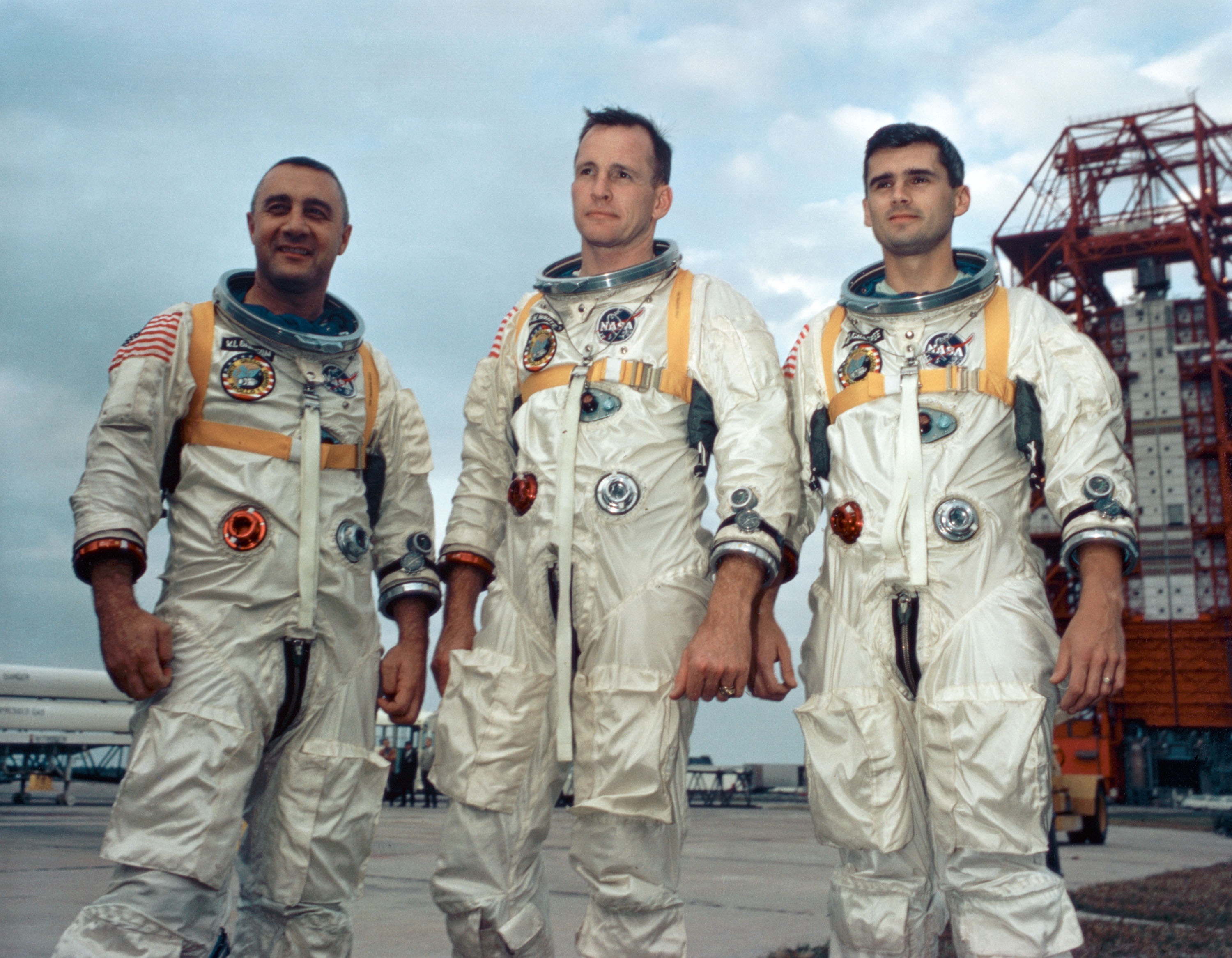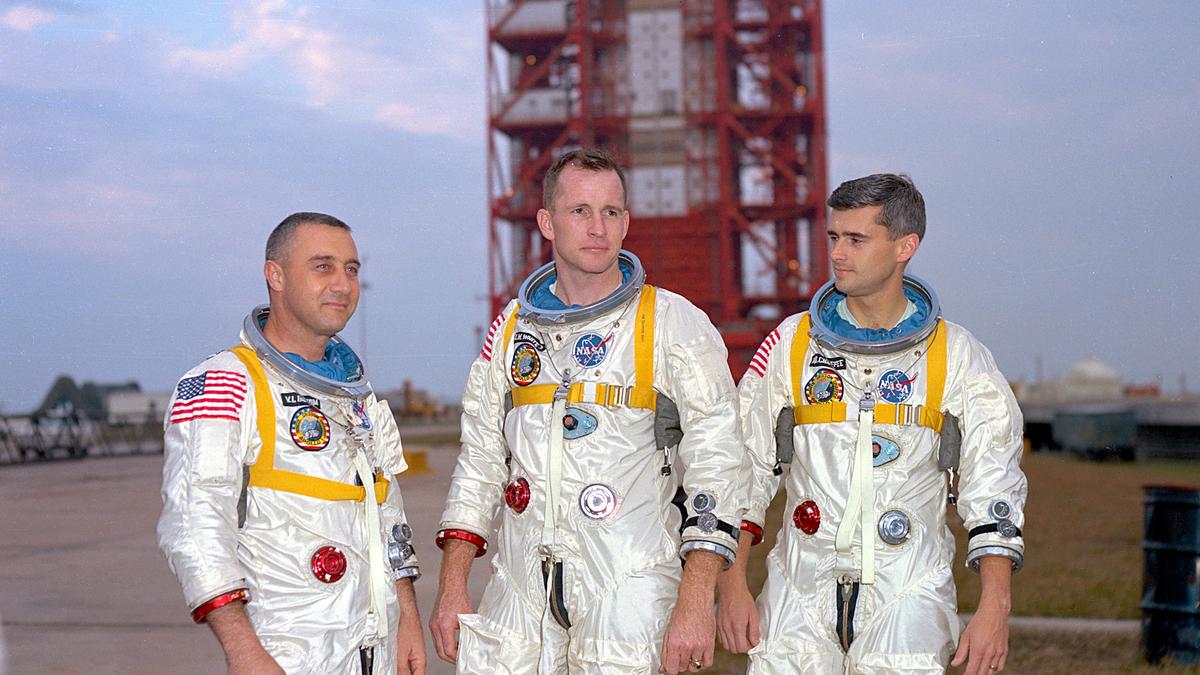
On January 27 1967, U.S. astronauts Virgil “Gus” Grissom, Ed White and Roger Chaffee died in a fire aboard the Apollo 1 spacecraft during a launch simulation at Florida’s Kennedy Space Center.
The Apollo program changed forever , when a flash fire swept through the Apollo 1 command module during a launch rehearsal test. The three men inside perished despite the best efforts of the ground crew. It would take more than 18 months, and extensive redesigns, before NASA sent more men into space.
The launch simulation on January 27, 1967, on pad 34, was a “plugs-out” test to determine whether the spacecraft would operate nominally on (simulated) internal power while detached from all cables and umbilicals.

Passing this test was essential to making the February 21 launch date. The test was considered non-hazardous because neither the launch vehicle nor the spacecraft was loaded with fuel or cryogenics, and all pyrotechnic systems (explosive bolts) were disabled
At 1:00 pm EST (1800 GMT) on January 27, first Grissom, then Chaffee, and White entered the Command Module fully pressure-suited, and were strapped into their seats and hooked up to the spacecraft’s oxygen and communication systems. Grissom immediately noticed a strange odor in the air circulating through his suit which he compared to “sour buttermilk”, and the simulated countdown was held at 1:20 pm, while air samples were taken. No cause of the odor could be found, and the countdown was resumed at 2:42 pm. The accident investigation found this odor not to be related to the fire.
Three minutes after the count was resumed, the hatch installation was started. The hatch consisted of three parts: a removable inner hatch, which stayed inside the cabin; a hinged outer hatch, which was part of the spacecraft’s heat shield; and an outer hatch cover, which was part of the boost protective cover enveloping the entire Command Module to protect it from aerodynamic heating during launch, and from launch escape rocket exhaust in the event of a launch abort. The boost hatch cover was partially, but not fully, latched in place because the flexible boost protective cover was slightly distorted by some cabling run under it to provide the simulated internal power. (The spacecraft’s fuel cell reactants were not loaded for this test.) After the hatches were sealed, the air in the cabin was replaced with pure oxygen at 16.7 psi (115 kPa), 2 psi (14 kPa) higher than atmospheric pressure.
The Apollo 1 crew commander, Virgil “Gus” Grissom, was an Air Force veteran of the Korean War. He was chosen was among NASA’s first group of seven astronauts, the Mercury Seven. Grissom was America’s second person in space in 1961. On that mission, Mercury’s Liberty Bell 7, the hatch door blew for unknown reasons upon splashdown. Grissom ended up in the water and was rescued by a helicopter (which at first tried, in vain, to pick up the spacecraft; the spacecraft was later pulled from the ocean floor in 1999).
Some in the Astronaut Office were skeptical that Grissom’s reputation would recover (many believed Grissom blew the hatch; he swore he didn’t). However, Grissom successfully commanded the first Gemini flight, Gemini 3, and was selected to do the same for Apollo.
Fellow spaceflight veteran Ed White, an Air Force lieutenant colonel, was the first American to make a spacewalk, on Gemini 4 in 1965. The images of him soaring in space for 23 minutes are still frequently seen today; it is considered one of history’s most memorable spacewalks.
Roger Chaffee was a seasoned Navy lieutenant commander who joined the program in 1963. Although a rookie in space, he had spent years supporting the Gemini program, most publicly as CapCom on Gemini 4. Now getting a chance to fly after five years in the program, he said, “I think it will be a lot of fun.”

Every astronaut in the Apollo program had flight experience, and many were test pilots. They were used to seeing machines under development and dealing with delays, and assessing the airplanes’ readiness for flight. In the view of many of these astronauts, the Apollo command module just wasn’t ready yet. Engineering changes were still in progress as NASA prepared for the countdown test.
On his last visit home in Texas, Jan. 22, 1967, Grissom grabbed a lemon off a citrus tree in the backyard. His wife, Betty, asked what he was going to do with it. “I’m going to hang it on that spacecraft,” he answered as he kissed her goodbye. He hung it on the flight simulator after he arrived at the Cape.
The morning of the test, the crew suited up and detected a foul odor in the breathing oxygen, which took about an hour to fix. Then the communications system acted up. Shouting through the noise, Grissom vented: “How are we going to get to the moon if we can’t talk between two or three buildings?”
With communications problems dragging on, the practice countdown was held. Then at 6:31 p.m. came a frightening word from the spacecraft: “Fire.”
Deke Slayton, who oversaw crew selections at NASA and was present for the test, could see white flames in a closed-circuit television monitor pointing toward the spacecraft. The crew struggled to get out. Technicians raced to the scene, trying to fight the fire with extinguishers amid faulty breathing masks. [Video: Apollo 1 Remembered – Report from the Archives]
At last, the door was open, but it was too late.

I am passionate about my site and I know you all like reading my blogs. I have been doing this at no cost and will continue to do so. All I ask is for a voluntary donation of $2, however if you are not in a position to do so I can fully understand, maybe next time then. Thank you.
To donate click on the credit/debit card icon of the card you will use. If you want to donate more then $2 just add a higher number in the box left from the PayPal link. Many thanks.















You must be logged in to post a comment.